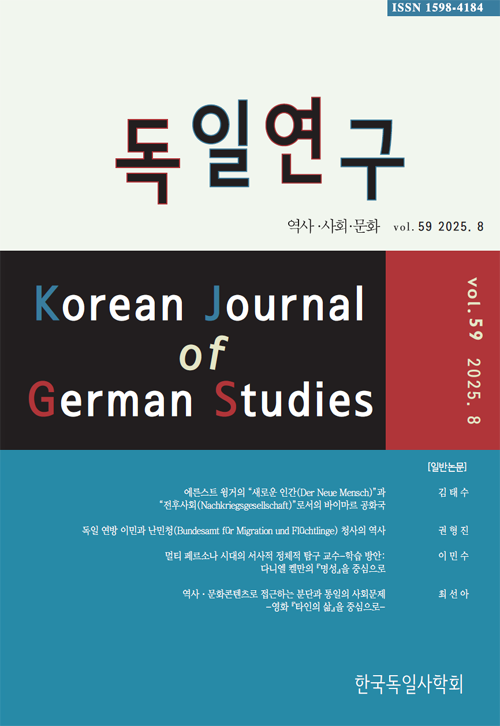- 영문명
- History of the Federal Office building for Migration and Refugees in Germany(Bundesamt für Migration und Flüchtlinge, BAMF)
- 발행기관
- 한국독일사학회
- 저자명
- 권형진(Hyeoungjin Kwon)
- 간행물 정보
- 『독일연구』Vol.59, 41~86쪽, 전체 46쪽
- 주제분류
- 인문학 > 역사학
- 파일형태
- 발행일자
- 2025.08.31
8,320원
구매일시로부터 72시간 이내에 다운로드 가능합니다.
이 학술논문 정보는 (주)교보문고와 각 발행기관 사이에 저작물 이용 계약이 체결된 것으로, 교보문고를 통해 제공되고 있습니다.

국문 초록
뉘른베르크의 나치 전당대회장 건설은 히틀러에 의해 진행된 가장 대표적인 도시건설 계획 중 하나였다. 1936년부터 나치 정권의 본격적인 선전장이 되었던 전당대회장은 대내외적으로 나치즘을 상징하는 공간이 되었다. 리펜슈탈의 영상기록 ‘의지의 승리’(1935)와 나치의 인종차별법령인 ‘뉘른베르크 법(Nürnberger Gesetze)’이 그 증거이다. 이 거대한 전당대회장에는 나치스의 성스러운 공간을 보호할 친위대를 위한 병영도 건설되었다. 현재 남아 있는 건축물 중 하나인 친위대 병영은 나치 과거사에 대한 기억과 반성의 공간으로 사용하고 있는 체펠린 광장이나 콩그레스 홀과 달리 독일 연방 이민과 난민 청사로 사용되고 있다.
친위대 대장 히믈러의 주도로 건설된 친위대 병영은 1938년에 공사를 시작해 1940년 완공되었다. 병영건설의 목적은 친위대가 나치 전당대회장의 경비와 행사의 진행을 주도하기 위해서였다. 그러나 1939년 2차 대전이 발발하면서, 이러한 목적은 달성될 수 없었다. 병영은 친위대 통신대의 훈련을 위한 공간이 되었다. 1941년부터는 다카우와 플로센부르크 집단 수용소의 외부 수용소로 뉘른베르크 지역의 산업시설에 노동력을 공급하는 역할을 했다.
1945년 전쟁이 끝나고, 친위대 병영은 미군이 점령하고 메럴 병영이라고 이름을 바꿨다. 1947년까지 메럴 병영은 나치 정권에 의해 강제로 끌려온 해방된 외국인 강제노동수용자들을 위한 임시 수용소로 사용되었다. 1952년부터 1992년까지 메럴 병영은 독일에 주둔하는 미제2기갑기병연대의 병영으로 사용되었다. 메럴 병영은 냉전으로 표현되는 세계질서의 상징적 공간이었으며 동시에 미군의 병든 병영문화가 공존하는 공간이었다.
독일이 통일되고 미군이 철수하면서 메럴 병영의 역사는 새롭게 쓰일 수 있었다. 병영 건물이라는 태생적 한계를 극복하고, 이 건축물은 지금까지와는 전혀 다른 목적으로 활용될 수 있게 되었다. 1998년 병영 본관 건물에 연방 외국난민인정청이 들어오면서 인도주의적 목적을 실현하는 공간이 되었다. 2005년 이민법의 시행으로 연방 이민난민청으로 이름이 바뀌어 현재에 이른다. 이와함께 장교숙소 건물이었던 Z-건물이 2015년부터 뉘른베르크의 젊은 문화예술인들을 위한 현대문화센터가 되면서 나치 과거사를 극복하는 새로운 방식이 제시되었다. 나치 이데올로기를 체화하는 친위대의 병영이 가지고 있던 ‘배제’의 공간이 인도주의적인 난민정책과 이민자들의 사회통합을 위한, 그리고 젊은 예술인들의 문화가 어우러지는 ‘통합’의 공간으로 변신했다.
영문 초록
The construction of the Nazi Party rally grounds(Reichsparteitagsgelände) in Nürnberg was one of the most representative city construction plans carried out by Hitler.(Site of the Nazi Party Rallies; Stadt der Reichsparteitage) The Nazi Party rally grounds, which has been a full-fledged propaganda ground for the Nazi regime since 1936, has become a space that symbolizes Nazism both internally and externally. Riefenstahl’s documentary of 1935 ‘Triumph of the Will’ and the Nazi racist law ‘Nürnberger Gesetze’ are evidence of this. A SS barracks were also built in this huge Nazi Party rally grounds to protect the sacred spaces of the Nazis.
Unlike Zeppelin Field and Congress Hall, which are used as spaces for memory and reflection on Nazi history, the SS barracks, one of the remaining buildings, is used as a federal office for immigration and refugees in Germany. Construction of the SS barracks, built under the order of SS leader Himmler, began in 1938 and was completed in 1940. The purpose of the barracks construction was for the SS to lead the security and events of the Nazi Party rally. However, with the outbreak of World War II in 1939, these objectives could not be achieved. The barracks became a space for the training of the SS’s communications unit. From 1941 it served as an external camp for the Dachau and Flossenbürg concentration camps, supplying labor to industrial facilities in the Nürnberg region.
After the war ended in 1945, the SS barracks were taken over by the U.S. military and renamed Merrell barracks. Until 1947, Merrell Barracks had been used as a temporary camp for freed foreign forced laborers brought in by the Nazi regime. From 1952 to 1992, the Merrell barracks were used as barracks for the 2nd U.S. Armored Cavalry Regiment in Germany. The Merrell barracks were a symbolic space of the world order expressed by the Cold War, and at the same time, it was a space where the barracks culture of the U.S. military, which was sickened by drug and crimes, coexisted.
The history of Merrell's barracks could be rewritten as Germany was unified and U.S. troops withdrew. Overcoming the inherent limitations of a barracks building, this building can be used for a completely different purpose than before. In 1998, when the Federal Office for the Recognition of Foreign Refugees entered the main building of the barracks, it became a space to realize humanitarian purposes. With the enforcement of the Immigration Act in 2005, the name of federal office was changed to the Federal Office for Immigration and Refugees. At the same time, the Z-building, which was an SS officer’s residence building, has become a modern cultural center for young cultural artists in Nürnberg since 2015, suggesting a new way to overcome Nazi history. The space of ‘exclusion’ and ‘discrimination’ held by the SS's barracks embodying Nazi ideology has transformed into a space of ‘integration’ that combines humanitarian refugee policy, social integration of immigrants, and the culture of young artists.
목차
Ⅰ. 들어가며
Ⅱ. 나치 전당대회장의 친위대 병영(SS Kaserne) 건설
Ⅲ. 전쟁과 병영의 용도 변화
Ⅳ. 임시 수용소에서 서독 주둔 미군 병영으로의 전환
Ⅴ. 이민자와 난민 그리고 문화를 위한 공간으로의 재탄생
Ⅵ. 나오며
참고문헌
키워드
해당간행물 수록 논문
참고문헌
교보eBook 첫 방문을 환영 합니다!

신규가입 혜택 지급이 완료 되었습니다.
바로 사용 가능한 교보e캐시 1,000원 (유효기간 7일)
지금 바로 교보eBook의 다양한 콘텐츠를 이용해 보세요!



